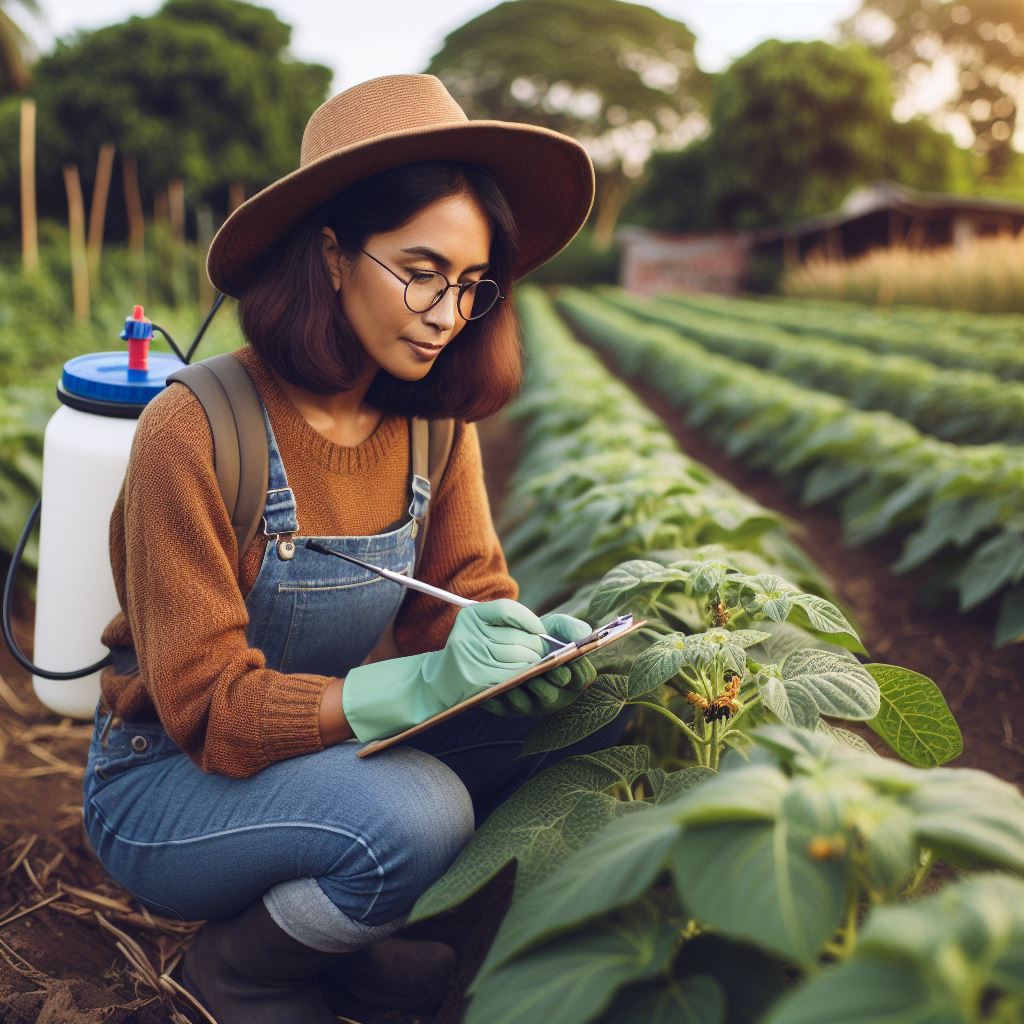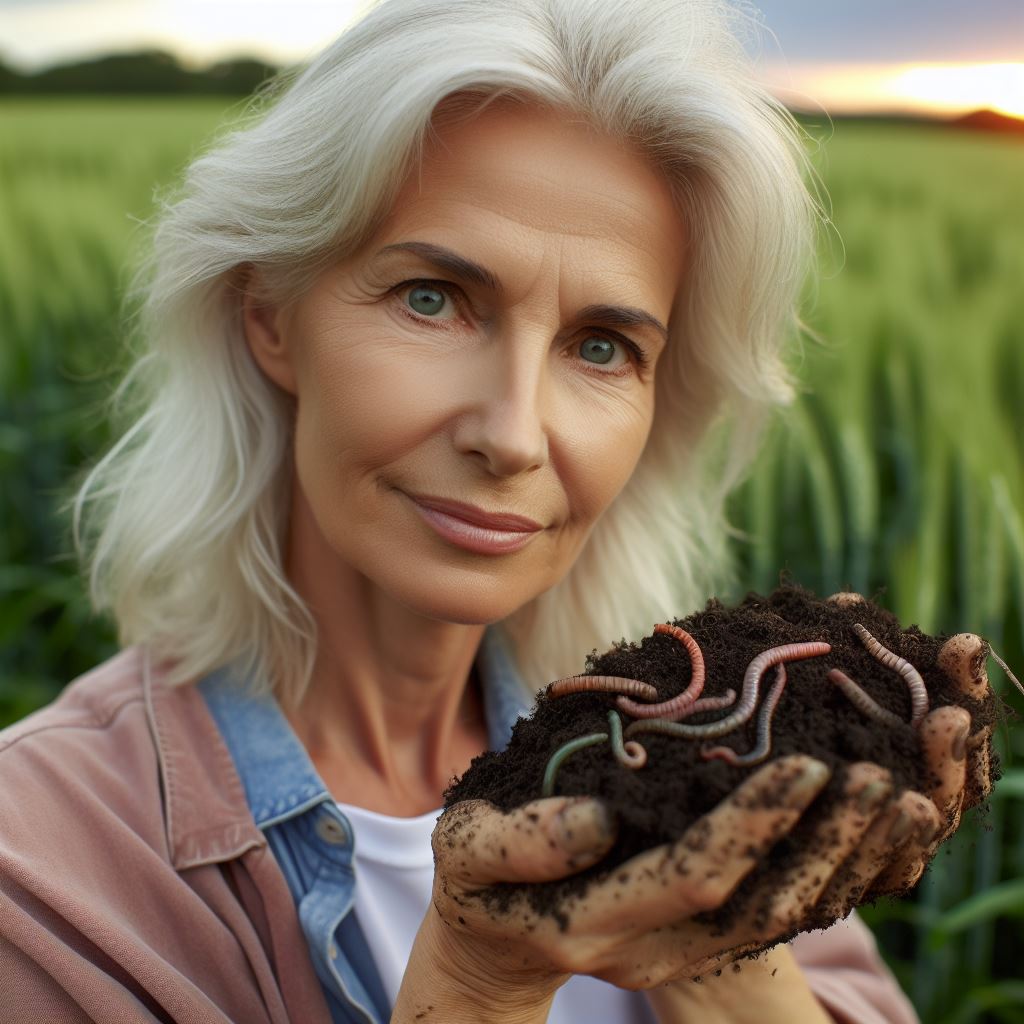Introduction
Sustainable pest control in agriculture refers to the use of practices that minimize pest damage while protecting the environment.
Sustainable pest control is crucial for farmers as it helps increase crop yields and reduce economic losses. It also promotes ecological balance and biodiversity.
Integrated Pest Management (IPM) is a sustainable approach that combines various techniques to control pests effectively.
IPM focuses on prevention, using cultural, biological, and physical control methods first before resorting to chemical pesticides.
Crop rotation and diversity plays a vital role in sustainable pest control by disrupting pest life cycles and reducing pest populations.
Biological control involves using natural enemies such as predators, parasites, and pathogens to regulate pest populations.
Utilization of pheromones and traps can help monitor and control pests without harming beneficial insects.
Sustainable pest control practices minimize the risks of chemical exposure to farmers, consumers, and the environment.
These practices promote the preservation of beneficial insects, such as pollinators, and protect biodiversity.
Using sustainable pest control methods reduces the development of pesticide resistance in pests.
Farmers can save costs in the long run as sustainable pest control methods require less input and reduce dependence on chemical pesticides.
Sustainable pest control in agriculture is crucial for the long-term success of farmers and the preservation of the environment.
By utilizing integrated pest management and other sustainable methods, farmers can effectively control pests while minimizing negative impacts on the ecosystem.
Traditional approaches to pest control
Chemical pesticides
Chemical pesticides have been widely used in agriculture for decades to combat pest infestations.
These substances are designed to kill or control pests, including insects, fungi, and weeds.
Transform Your Agribusiness
Unlock your farm's potential with expert advice tailored to your needs. Get actionable steps that drive real results.
Get StartedWhile they have been effective in managing pest populations and increasing crop yields, there are potential negative effects associated with their use.
Environmental impact
Chemical pesticides can have harmful effects on the environment.
When sprayed on crops, they can leach into soil and contaminate water sources, leading to the pollution of rivers, lakes, and groundwater.
This can disrupt aquatic ecosystems and harm other non-target organisms, such as beneficial insects, birds, and mammals.
Resistance and pest resurgence
Over time, pests can develop resistance to chemical pesticides, rendering them less effective.
This creates a need for higher application rates or the use of stronger pesticides, leading to a vicious cycle of escalating chemical use.
Moreover, by eliminating pests’ natural predators, chemical pesticides can cause pest populations to rebound, resulting in further damage to crops.
Health risks
Chemical pesticides can pose risks to human health. Agricultural workers who handle and apply these substances are particularly vulnerable to exposure.
Prolonged or excessive contact with pesticides can lead to acute or chronic health problems, including skin irritations, respiratory issues, neurological disorders, and even cancer.
Potential negative effects on the environment and human health
Soil degradation
Chemical pesticides can disrupt the balance of soil ecosystems.
The overuse of these substances can reduce beneficial soil organisms, such as earthworms and microorganisms, leading to soil degradation and decreased fertility.
This can have long-term implications for sustainable agriculture.
Water contamination
As mentioned earlier, chemical pesticides can contaminate water sources through runoff and leaching.
This pollution not only affects aquatic life but can also compromise the quality of drinking water, posing risks to human health.
It is crucial to ensure water sources remain uncontaminated for both agriculture and public consumption.
Non-target species and biodiversity loss
Chemical pesticides do not discriminate between pests and beneficial organisms.
They can harm or kill non-target species such as bees and butterflies, which play vital roles in pollination.
The loss of these pollinators can have severe consequences for agricultural production and biodiversity as a whole.
In short, traditional approaches to pest control, such as chemical pesticides, have proven effective in managing pests and increasing crop yields.
However, they come with potential negative effects on the environment and human health.
The impact on soil degradation, water contamination, and biodiversity loss highlights the importance of adopting sustainable pest control methods in agriculture.
By prioritizing alternatives that minimize harm to ecosystems and human well-being, we can achieve a more sustainable and responsible approach to pest management.
Read: Building a Permaculture Garden at Home
Sustainable pest control methods
Integrated Pest Management (IPM) approach
Pest control is a critical aspect of agriculture, ensuring healthy yields and safeguarding the environment.
Showcase Your Farming Business
Publish your professional farming services profile on our blog for a one-time fee of $200 and reach a dedicated audience of farmers and agribusiness owners.
Publish Your ProfileAs traditional methods often involve the use of harmful chemical pesticides, sustainable pest control methods have gained popularity.
One such approach is Integrated Pest Management (IPM), which emphasizes the use of environmentally friendly techniques.
Definition and principles of IPM
IPM is an ecosystem-based strategy that focuses on long-term pest control while minimizing environmental damage and reducing reliance on synthetic pesticides.
The aim is to integrate various pest control methods to achieve effective and sustainable results.
The principles of IPM include:
- Identifying and monitoring pests to understand their life cycles and behavior.
- Setting action thresholds to determine when intervention is necessary.
- Preventing pest problems through cultural practices such as crop rotation and proper sanitation.
- Using biological control agents, like predators and parasites, to manage pests naturally.
- Employing physical methods such as barriers and traps to control pests.
- Resorting to chemical pesticides only when necessary and using them judiciously.
- Evaluating the effectiveness of pest control measures and continuously improving strategies.
Use of biological control agents
One of the key components of IPM is the implementation of biological control agents, which are organisms that naturally regulate pest populations. These agents can be predators, parasites, or pathogens.
Predatory insects like ladybugs and lacewings feed on pests, while parasites lay eggs inside pest bodies, eventually leading to their demise.
Pathogens, such as bacteria or fungi, infect pest populations, reducing their numbers.
Using biological control agents not only reduces reliance on chemical pesticides but also promotes a balanced ecosystem and protects beneficial organisms.
Crop rotation and diversification
Crop rotation and diversification play crucial roles in sustainable pest control.
By varying the types of crops grown in a particular area, farmers can disrupt the life cycles of pests and reduce their populations.
Each crop has specific pests and diseases associated with it. By rotating crops, these pests and diseases are forced to seek alternative hosts or die out, preventing their buildup in the soil.
Furthermore, diversifying crops can create habitats for natural enemies, enhancing biological control.
Crop rotation and diversification not only control pests but also improve soil fertility and minimize nutrient depletion, leading to sustainable agriculture practices.
Monitoring and early detection of pests
An essential aspect of IPM is monitoring and early detection of pests.
Regular inspection of crops allows farmers to identify pests at an early stage, preventing potential infestations and subsequent damage.
Monitoring methods include trapping pests using sticky traps, pheromone traps, or visual inspections.
By understanding pest behavior and population dynamics, farmers can implement timely control measures and prevent economic losses.
Early detection is crucial in IPM as it enables the application of targeted and environmentally friendly pest control strategies, reducing the need for extensive pesticide use.
In fact, sustainable pest control methods, such as the Integrated Pest Management approach, are vital for promoting environmentally friendly agriculture.
By implementing IPM principles, using biological control agents, practicing crop rotation and diversification, and monitoring pests, farmers can effectively manage pest populations while minimizing harm to the environment and ensuring long-term agricultural sustainability.
Read: Composting Techniques for Healthier Soil
Benefits of Sustainable Pest Control
Agriculture plays a crucial role in feeding the world’s growing population.
However, the excessive use of synthetic pesticides in conventional farming practices has led to detrimental effects on the environment and human health.
As a result, there is a growing need for sustainable pest control methods that prioritize the preservation of ecosystem balance.
In this section, we will explore the benefits of adopting sustainable pest control practices.
Preservation of Ecosystem Balance
One of the key advantages of sustainable pest control is the preservation of ecosystem balance.
Unlike synthetic pesticides that indiscriminately kill pests, sustainable methods focus on integrated pest management (IPM) techniques.
IPM involves a combination of biological, mechanical, and cultural control strategies to manage pests effectively.
By avoiding the widespread use of synthetic pesticides, sustainable pest control methods allow for the conservation of beneficial insects, such as pollinators, that play crucial roles in maintaining biodiversity.
These techniques help maintain a healthy ecosystem by preventing the disruption of natural food chains and reducing the risk of extinction for vulnerable species.
Reduced Reliance on Synthetic Pesticides
Sustainable pest control practices aim to reduce the reliance on synthetic pesticides. This shift is crucial considering the negative impacts of these chemicals on human health.
Prolonged exposure to synthetic pesticides has been linked to various health problems, including cancer, neurodevelopmental disorders, and hormonal imbalances.
By implementing sustainable alternatives, farmers can protect the health of themselves, their workers, and consumers.
Biological control methods, such as the use of beneficial insects or microorganisms, can effectively control pests without introducing harmful chemical compounds into the environment.
This reduced reliance on synthetic pesticides leads to a healthier and safer agricultural system.
Cost-effectiveness for Farmers
Implementing sustainable pest control practices can also bring significant cost savings for farmers.
While initial investments may be required to establish integrated pest management systems, the long-term benefits outweigh the costs.
Sustainable methods provide a more sustainable and resilient approach to pest control, reducing the need for frequent pesticide applications.
Moreover, sustainable pest control practices often involve the use of locally available resources.
Showcase Your Farming Business
Publish your professional farming services profile on our blog for a one-time fee of $200 and reach a dedicated audience of farmers and agribusiness owners.
Publish Your ProfileFor example, farmers can attract beneficial insects by planting specific native plants or creating habitat corridors.
This reduces dependence on costly synthetic pesticides, making sustainable pest control a cost-effective solution for farmers in the long run.
In essence, adopting sustainable pest control practices offers numerous benefits for agriculture.
By preserving ecosystem balance, reducing reliance on synthetic pesticides, and providing cost-effective solutions for farmers, sustainable pest control helps cultivate a healthier and more environmentally friendly agricultural system.
Read: Water Conservation in Permaculture Design

Success Stories of Sustainable Pest Control in Agriculture
Case Studies of Farms Implementing IPM Successfully
- Jones Farm in California effectively implemented Integrated Pest Management (IPM) techniques.
- By utilizing biological controls and crop rotation, Jones Farm reduced pesticide use by 75%.
- They successfully controlled pests like aphids, mites, and caterpillars through proactive monitoring.
- The implementation of pheromone traps and insect-repelling plants further enhanced their pest control.
- Jones Farm’s case study demonstrated that IPM can be successfully applied to achieve sustainable pest control.
Positive Outcomes and Improved Farm Productivity
- Smith Orchard in Oregon experienced significant improvements in farm productivity after implementing sustainable pest control methods.
- By adopting techniques like precision agriculture and releasing beneficial insects, the orchard saw positive results.
- Smith Orchard observed a reduction in crop damage caused by pests, leading to higher yields and improved quality.
- The use of pheromone dispensers to disrupt pest mating patterns resulted in a decrease in pest population.
- This ultimately led to decreased dependence on chemical pesticides and a more environmentally friendly approach.
Organic Vegetable Farm in Vermont
- Green Acres Organic Farm in Vermont achieved success in sustainable pest control by focusing on crop diversity.
- By growing a wide variety of vegetables, the farm minimized the risk of pest infestations.
- The presence of different plants created an ecosystem that attracted beneficial insects, providing natural pest control.
- With minimal pesticide use, Green Acres Organic Farm produced bountiful harvests while maintaining soil fertility.
- Their success story highlighted the importance of biodiversity and eco-friendly practices in pest control.
Integrated Pest Management in Rice Cultivation
- Farmers in Southeast Asia embraced Integrated Pest Management (IPM) to combat pests in rice cultivation.
- A study conducted in Vietnam showed that IPM techniques significantly reduced pesticide dependency.
- The introduction of ducks into rice fields, known as the “duck-rice system,” effectively controlled pests like snails.
- Farmers saw increased rice yields and lowered production costs due to reduced pesticide purchases.
- This approach resulted in sustainable pest control while providing an additional income source through duck farming.
Pest Control Success in Organic Cotton Farming
- Organic cotton farmers in India adopted sustainable pest control methods to protect their crops.
- By utilizing trap crops and beneficial insects, farmers effectively managed pests without relying on chemical pesticides.
- Incorporating neem oil and biopesticides also played a vital role in controlling pest populations sustainably.
- These practices led to improved cotton yields, reduced pesticide residue, and better market acceptance for organic cotton.
- The success of organic cotton farming showcased the viability of sustainable pest control in agriculture.
Overall, these success stories from various farms implementing sustainable pest control techniques demonstrate the benefits and effectiveness of practices such as Integrated Pest Management (IPM).
By reducing pesticide usage, encouraging biodiversity, and implementing innovative methods, farmers can achieve improved farm productivity while minimizing environmental risks.
These success stories serve as inspiration for other farmers to embrace sustainable pest control strategies and contribute to a more sustainable agriculture industry.
Read: Eco-Farming: Sustainable Practices Overview
Challenges and Limitations of Sustainable Pest Control
Knowledge and Skill Requirements for Farmers
- Farmers need to acquire a deep understanding of sustainable pest control methods.
- They must learn about integrated pest management techniques to effectively manage pests.
- Training programs and educational resources should be made accessible to help farmers gain necessary knowledge.
- Farmers need to develop skills in identifying pests, understanding their life cycles, and implementing control measures.
- Continuous learning and staying updated with scientific advancements is crucial for effective pest management.
Availability and Accessibility of Biological Control Agents
- Biological control agents are living organisms used to control pest populations.
- Availability and accessibility of these agents can be a major challenge for farmers.
- Farmers may face difficulties in sourcing and obtaining beneficial insects or organisms.
- There is a need for reliable suppliers and distribution networks to ensure accessibility of biological control agents.
- Research and development efforts should focus on mass production and widespread availability of these agents.
Economic Barriers and Costs Involved
- Implementing sustainable pest control practices can involve significant costs for farmers.
- Initial investments in infrastructure, equipment, and technologies may be required.
- Costs associated with training programs, acquiring knowledge, and skill development can add up.
- The economic feasibility of sustainable pest control methods must be carefully evaluated.
- Financial support programs and incentives can help alleviate the economic burden for farmers.
Despite these challenges and limitations, it is important to recognize the benefits and long-term rewards of sustainable pest control in agriculture.
By investing in knowledge and skills, accessing biological control agents, and addressing economic barriers, farmers can contribute to a more sustainable and environmentally friendly agricultural system.
Emerging technologies for sustainable pest control
Achieving sustainable pest control in agriculture is vital to ensure the long-term viability of our food production systems.
Traditional methods of pest control, such as the use of chemical pesticides, often have detrimental effects on the environment and human health.
Fortunately, emerging technologies offer promising solutions to address these challenges and enable sustainable pest management.
Use of precision agriculture and remote sensing
- Precision agriculture involves the use of advanced technologies, such as GPS and drones, to optimize the application of pesticides.
- By precisely targeting areas affected by pests, farmers can reduce pesticide use and minimize the impact on beneficial insects and the ecosystem.
- Remote sensing techniques, such as satellite imagery and aerial surveys, provide real-time data on crop health and pest infestations.
- This data allows farmers to implement timely interventions and prevent pest outbreaks, reducing the need for extensive pesticide applications.
- Moreover, precision agriculture enables farmers to monitor and manage their crops more efficiently, improving overall productivity and sustainability.
Application of genetic engineering methods for pest resistance
- Genetic engineering offers a promising approach to develop crop varieties resistant to pests.
- By introducing specific genes into plants, scientists can enhance their ability to defend against pests without the need for chemical pesticides.
- For example, genetically engineered crops, such as Bt cotton, produce toxins that target specific pests while being harmless to non-target organisms.
- This technology reduces the reliance on chemical pesticides, promoting sustainable pest control practices.
- However, extensive research and strict regulatory measures are essential to ensure the safety and effectiveness of genetically modified organisms.
Role of data analytics and artificial intelligence in pest management
- Data analytics and artificial intelligence (AI) play a crucial role in optimizing pest management strategies.
- By analyzing vast amounts of data, AI algorithms can identify patterns and predict pest outbreaks more accurately.
- This early detection allows farmers to take proactive measures, such as targeted pest control interventions, before significant damage occurs.
- Furthermore, AI-powered systems can continuously learn and adapt, improving the efficiency and effectiveness of pest management over time.
- Combined with data analytics, AI empowers farmers to make data-driven decisions, optimizing pesticide use and minimizing environmental impact.
In general, emerging technologies present promising opportunities for sustainable pest control in agriculture.
Precision agriculture and remote sensing enable more precise and targeted pesticide applications, reducing environmental harm.
Genetic engineering methods allow for the development of pest-resistant crop varieties, reducing reliance on chemical pesticides.
Data analytics and artificial intelligence enhance pest management strategies by providing early detection and optimizing interventions.
By embracing these technologies, farmers can achieve sustainable pest control practices that ensure the long-term health of our food production systems.
Conclusion
Throughout this blog post, we have highlighted the significance of implementing sustainable pest control methods in agriculture.
We have seen that traditional pest control techniques, such as chemical pesticides, not only harm the environment but also pose health risks to humans.
On the other hand, sustainable pest control methods focus on minimizing the use of harmful chemicals and emphasizing natural alternatives.
These methods prioritize maintaining a balance between pest management and environmental conservation, which is crucial for long-term agricultural sustainability.
To ensure the well-being of our ecosystems and the health of future generations, it is essential for farmers to embrace sustainable pest control practices.
By adopting integrated pest management (IPM), farmers can reduce their reliance on chemical pesticides, protect pollinators, and promote biodiversity on their farms.
Although significant progress has been made in sustainable pest control, there is still a need for continued research and innovation.
Scientists, farmers, and industry experts must collaborate to develop novel techniques, biocontrol agents, and monitoring systems that are effective, economically viable, and environmentally friendly.
To ensure a sustainable and profitable agricultural sector, it is crucial that all stakeholders invest in the development and adoption of sustainable pest control practices.
Let us work together to protect our crops, ecosystems, and future generations.




